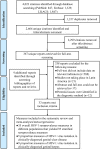Herpes simplex virus type 1 epidemiology in Latin America and the Caribbean: Systematic review and meta-analytics
- PMID: 31009486
- PMCID: PMC6476500
- DOI: 10.1371/journal.pone.0215487
Herpes simplex virus type 1 epidemiology in Latin America and the Caribbean: Systematic review and meta-analytics
Abstract
Objectives: To investigate the epidemiology of herpes simplex virus type 1 (HSV-1) in Latin America and the Caribbean.
Methods: Systematic review and meta-analytics guided by the Cochrane Collaboration Handbook and reported following the PRISMA guidelines.
Results: Thirty-three relevant reports were identified including 35 overall (and 95 stratified) seroprevalence measures, and five and nine proportions of virus isolation in genital ulcer disease (GUD) and in genital herpes, respectively. Pooled mean seroprevalence was 57.2% (95% CI: 49.7-64.6%) among children and 88.4% (95% CI: 85.2-91.2%) among adults. Pooled mean seroprevalence was lowest at 49.7% (95% CI: 42.8-56.6%) in those aged ≤10, followed by 77.8% (95% CI: 67.9-84.8%) in those aged 10-20, 82.8% (95% CI: 73.1-90.8%) in those aged 20-30, 92.5% (95% CI: 89.4-95.1%) in those aged 30-40, and 94.2% (95% CI: 92.7-95.5%) in those aged ≥40. Age was the strongest source of heterogeneity in seroprevalence, explaining 54% of variation. Evidence was found for seroprevalence decline over time. Pooled mean proportion of HSV-1 isolation was 0.9% (95% CI: 0.0-3.6%) in GUD and 10.9% (95% CI: 4.4-19.4%) in genital herpes.
Conclusions: HSV-1 is a widely prevalent infection in this region, but its epidemiology may be slowly transitioning, with still limited contribution for HSV-1 in genital herpes.
Conflict of interest statement
The authors have declared that no competing interests exist.
Figures


Similar articles
-
Epidemiology of herpes simplex virus type 2 in Latin America and the Caribbean: systematic review, meta-analyses and metaregressions.Sex Transm Infect. 2021 Nov;97(7):490-500. doi: 10.1136/sextrans-2021-054972. Epub 2021 Jun 4. Sex Transm Infect. 2021. PMID: 34088792 Free PMC article.
-
The Epidemiology of Herpes Simplex Virus Type 1 in Asia: Systematic Review, Meta-analyses, and Meta-regressions.Clin Infect Dis. 2019 Feb 15;68(5):757-772. doi: 10.1093/cid/ciy562. Clin Infect Dis. 2019. PMID: 30020453 Free PMC article.
-
Herpes simplex virus type 1 epidemiology in Africa: Systematic review, meta-analyses, and meta-regressions.J Infect. 2019 Oct;79(4):289-299. doi: 10.1016/j.jinf.2019.07.012. Epub 2019 Jul 31. J Infect. 2019. PMID: 31376458
-
Epidemiology of herpes simplex virus type 1 in Canada: systematic review, meta-analyses, and meta-regressions.Front Public Health. 2023 Jul 14;11:1118249. doi: 10.3389/fpubh.2023.1118249. eCollection 2023. Front Public Health. 2023. PMID: 37521995 Free PMC article.
-
Epidemiology of herpes simplex virus type 1 and genital herpes in Australia and New Zealand: systematic review, meta-analyses and meta-regressions.Epidemiol Infect. 2023 Feb 8;151:e33. doi: 10.1017/S0950268823000183. Epidemiol Infect. 2023. PMID: 36750224 Free PMC article.
Cited by
-
High silent prevalence of human herpesvirus 1 (HSV-1) infection affecting the indigenous reservation of the municipality of Dourados, Central-West Brazil.BMC Infect Dis. 2024 Jul 17;24(1):700. doi: 10.1186/s12879-024-09497-5. BMC Infect Dis. 2024. PMID: 39020287 Free PMC article.
-
Low Prevalence of HSV-1 and Helicobacter pylori in HNSCC and Chronic Tonsillitis Patients Compared to Healthy Individuals.Diagnostics (Basel). 2023 May 19;13(10):1798. doi: 10.3390/diagnostics13101798. Diagnostics (Basel). 2023. PMID: 37238282 Free PMC article.
-
Herpes simplex virus type 1 in Europe: systematic review, meta-analyses and meta-regressions.BMJ Glob Health. 2020 Jul;5(7):e002388. doi: 10.1136/bmjgh-2020-002388. BMJ Glob Health. 2020. PMID: 32675066 Free PMC article.
-
Estimated global and regional incidence and prevalence of herpes simplex virus infections and genital ulcer disease in 2020: mathematical modelling analyses.Sex Transm Infect. 2025 May 19;101(4):214-223. doi: 10.1136/sextrans-2024-056307. Sex Transm Infect. 2025. PMID: 39658199 Free PMC article.
-
Epidemiology of herpes simplex virus type 2 in sub-Saharan Africa: Systematic review, meta-analyses, and meta-regressions.EClinicalMedicine. 2021 May 7;35:100876. doi: 10.1016/j.eclinm.2021.100876. eCollection 2021 May. EClinicalMedicine. 2021. PMID: 34027335 Free PMC article.
References
-
- Brady RC, Bernstein DI. Treatment of herpes simplex virus infections. Antiviral Res. 2004;61(2):73–81. . - PubMed
-
- Bernstein DI, Bellamy AR, Hook EW 3rd, Levin MJ, Wald A, Ewell MG, et al. Epidemiology, clinical presentation, and antibody response to primary infection with herpes simplex virus type 1 and type 2 in young women. Clin Infect Dis. 2013;56(3):344–51. Epub 2012/10/23. 10.1093/cid/cis891 - DOI - PMC - PubMed
Publication types
MeSH terms
LinkOut - more resources
Full Text Sources
Medical

